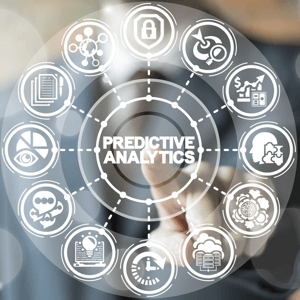10+ Marketing Predictions for 2019 From Top Marketers

In this lengthy piece from Lisa Jenkins put forth for Social Media Examiner some key trends that we should all be aware of.
- Smart Audio Requires Integration
- First-Party Data Acquisition Takes Precedence
- Individuals Reclaim Their Social Independence
- Brands Must Return Social to Social Media
- Consumers Flock to Passive YouTube-Type Experiences
- Brands Lean Into Controversy
- Predictive Analytics Become a Campaign Keystone
- LinkedIn Gains Prominence and Growth
- AR Volumetric Video Disrupts Social Media Video
- Facebook Video Experiences Evolve
- Marketers Give Email Its Due
How are you planning to work with these Social Trends trends as you plan your marketing and sales strategies. We'd love to know.
And If you want to get your business or sales funnel launched fast to attract clients consistently, do check out our IGNITE Business Accelerator Program that runs weekly though September and October and Is available Live Online or In Person for DC Area Residents held at the Reston Chamber of Commerce.
See you on the action-field,
Raksha Sukhia, SMB Growth Expert,
Founder BBR Network. #bbrnetwork
#1: Smart Audio Requires Integration
From a purely data-driven standpoint, we know that smart speaker shipments are up 137%. In fact, 100 million smart speakers will be sold next year. Amazon smart speakers reach 15% of U.S. homes and over 1 billion devices provide voice assistant access today. Gartner predicts that 30% of searches will be done without a screen in the next 2 years.
Twenty-eight percent of smart speaker owners buy things with them, and 84% of Amazon Echo users are satisfied. Amazon’s Alexa team is now 10,000 people strong.
But here’s the biggest deal about smart audio: voice is the ultimate user experience.
Whether it’s Alexa, Google Assistant, Siri, Cortana, or Bixby, voice assistant technology powered by smartphones and/or smart speakers (this is why I call it “smart audio”) removes the difficulties of typing, navigation, and much more. It’s an incredibly natural and intuitive way to interact, connect, and work with technology.
In the near future, the idea of typing will be relegated to “writing” and removed from the current user experience as more voice commands, content, and assistance take hold. Review the numbers and data points above and it’s clear: smart audio is the technology that all brands must focus on right now.

Back in September 2017, I published an article in Strategy magazine titled, Start thinking about your screen-less presence:
“It’s not just the ‘voice’ part but the ‘assistant’ part as well. These voice services are quickly being developed and integrated to solve consumer problems. From the little stuff (like ordering pizza) to the more complex (like diagnosing an illness). And, while this is all in its infancy, the speed of innovation, development, and deployment is staggering. Voice technology will change the way that consumers engage with brands and technology. There is no doubt.
Right now, brands need to be thinking very seriously about what their voice will be? What kind of advertising will work—right now—so that a brand can be the only result when a consumer is asking about them (or their services)? What kind of audio content should brands be developing right now to augment their advertising with relevant content (think about how blogging and content marketing is used to balance paid search results to date)? How big is the current market for voice and how long should a brand wait for this market to mature? Is there an ‘innovation lab’ play for brands today with voice? How will voice play out beyond these home assistant devices to smartphones, automobiles, and public spaces? Let’s face it: voice as navigation is where consumers want technology to be. Brands need to think about their role in this today.”
What a difference a year makes. Innovation and “nice to have” is no longer the path forward. Amazon’s most recent product launch should have set off a ton of alarms at every business in every sector. Alexa is now available in everything from a $60 microwave oven to a $20 Alexa unit for the car.
That said, not everybody is going to love this. We’re now inviting big brands that have too much data on us already to basically follow and listen in on our lives. But smart audio is like any other technological adoption: People love it when technology makes life a lot easier for them, and smart audio may be the ultimate engine of convenience.
And it’s still early days. When you think about smart audio, you have to frame it.
Right now, we’re at its nascent stages. In internet years, smart audio today is like the web browser before hyperlinks. There’s a lack of findability (you have to know what you’re asking for). There’s a lack of discoverability (smart audio isn’t able to make recommendations—yet—based on your profile or history). There’s a lack of content (think about SEO in the early days… the more content, the more SEO juice there will be). There’s a lack of marketing (lots of campaigns, stunts, etc., but no solid strategy for brands, voice, and smart audio).
It’s easy to think that smart audio is the next frontier, but it’s not. Smart audio is the now frontier.
Mitch Joel has been called a visionary, digital expert, and community leader. He is an entrepreneur, author, journalist, investor, trusted advisor, and passionate speaker who connects with people worldwide by sharing his insights on business transformation and innovation.
#2: First-Party Data Acquisition Takes Precedence
All in all, I’m bullish for content, digital, and the idea of data acquisition, specifically for building audiences. I see three key trends developing in content, social, and digital marketing in 2019.
First is the continued meteoric rise of automation and artificial intelligence within the technology stack. This is less an actual development than a loud technological buzz that will distract marketers from continuing to lay the foundation for their actual digital transformation. There is a distinct need for marketers, especially content marketing practitioners, to understand where automation and AI actually fit into the business. But the temptation—and there will be lots of it—will be to deploy AI solutions as some kind of cure-all.
The second trend will be the need to scale content-oriented operations. Businesses are finally taking content-as-a-business-function seriously enough to build a strategic operation around it. Watch for talent gaps to emerge and for things like “content syndication,” “content promotion,” and “audience development” to emerge as actual, meaningful items in the marketing budget.

The third trend is the continued increase in the importance of content marketing and the acquisition of first-party data in the new era of GDPR and other privacy laws/regulations that are coming online elsewhere in the world. As GDPR matures and new (probably U.S.-based) policies come online, businesses should watch for the opportunity to lean into first-party data acquisition, rather than rely on third-party data providers (like social media platforms) that will increasingly make it unavailable.
Robert Rose has more than 15 years of experience writing, keynoting, and speaking with groups of all sizes about the strategic transformation of marketing into content-driven customer experiences.
#3: Individuals Reclaim Their Social Independence
I predict that over the next 2 years, people will put an increasingly anxious focus on their social media standing.
Then, one by one, they’ll realize it’s not in their interest. That they have, in fact, become pawns in a system that views them as the product, not the customer.
Once that realization kicks in, I’m hoping that people will get back to first principles: the idea of seeing and being seen by the people who matter to them.
Seth Godin is an author, entrepreneur, and most of all, a teacher.
#4: Brands Must Return Social to Social Media
I’ve been fortunate to intimately observe the progression of social media marketing for more than a decade. But I’m not sure our recent progress has been positive. Instead of recognizing social media as an opportunity to strengthen the customer connection, companies have inexorably squeezed the “social” out of social media:
- Conversations gave way to broadcasting “content.”
- Social media became an IT function and was automated to the point of being soulless.
- Humans with personalities and names were replaced by corporate personas and branded voices.
- Success was measured in clicks and likes rather than relationships and loyalty.
- Social media’s primary role evolved to become a place to weaponize influencers.
Rather than social media fundamentally changing how marketing works, over the last 10 years, marketing fundamentally changed how social media works.
So how do we renew, refresh, and reimagine social media in a noisy world where brand loyalty is fading and engagement is in freefall?
In 2019, it’s time to take social media marketing back from the IT department and drive a truly human-centered approach to our customer relations. Social media can be a vital and effective channel if we use it to:
- Provide relevant human connections.
- Form reliable and trustworthy communication channels.
- Express shared values.
- Display human emotions like compassion, understanding, and empathy.
- Create unique and entertaining experiences.
- Demonstrate active involvement in local issues.
- Offer a dependable way to respond in a moment of customer need.
Social media still provides an essential chance to connect to customers and serve them, but most companies are missing the opportunity due to an outdated focus on “me-centric posts,” random acts of content, and misguided attempts to manufacture engagement.
2019 is the year we start putting the “social” back in social media. We really have no choice.
Mark Schaefer is a globally recognized keynote speaker, educator, business consultant, and author. His blog {grow} is hailed as one of the top marketing blogs in the world.
#5: Consumers Flock to Passive YouTube-Type Experiences
The pendulum is shifting away from active social interactions back to more traditional “passive” experiences.
As people begin to detox from social platforms that prompt and expect “interactions,” they’ll shift back to experiences that instead entertain, inform, and educate.
This means that people will spend a lot more time listening to podcasts, reading, and watching videos on platforms like YouTube. Facebook will become a short-duration “drive-by” experience for most people.

Smart marketers will begin to diversify their content publishing plans and create different organic and paid content that closely matches this behavior shift.
Michael Stelzner is CEO and founder of Social Media Examiner, and host of the Social Media Marketing Podcast.
#6: Brands Lean Into Controversy
In an era where it’s harder than ever to break through and every little thing can breed controversy, some companies are gaining attention (and customers) by leaning into delicate situations:
We’re seeing more organizations using their beliefs and cultural DNA to galvanize a portion of their potential customer base. While these moves turn off some consumers, of course, (witness people burning Nike gear after the Kaepernick ad debuted), they also increase kinship between like-minded customers and the company. And when kinship is greatly diminished or significantly increased, it often manifests in social media chatter.

One way to create customer conversations on social media and beyond is to develop and implement a sustained word-of-mouth strategy rooted in company operations like DoubleTree Hotels and their free cookie gifted at check-in. The other way is to take a stand.
We’re going to see more of both approaches in 2019 and beyond because they dramatically increase reach at comparatively low cost.
Jay Baer, CPAE, president of Convince & Convert, is a 7th generation entrepreneur, a New York Timesbest-selling author of 6 books, and the founder of 5 multimillion-dollar companies.
#7: Predictive Analytics Become a Campaign Keystone
Marketing will be dealing with economic headwinds in 2019. Anyone looking at leading economic indicators sees the writing on the wall—a recession in 12-18 months driven in part by inept economic policies.
Thus, marketers will need to be focusing on ROI and results.

This will be an interesting time; marketers have had it easy over the last decade with sustained economic growth and ever-cheaper software and services. If we think back to 2008 when the last headwinds hit and we had the great recession, there aren’t many marketers who were working in the space at that time—certainly no one under 30 as a full-time marketing professional.
Predictive analytics will be a keystone of marketing for the savvy marketer because few things help conserve budget and resources like knowing what’s likely to happen.
Christopher S. Penn is the co-founder of Trust Insights, and is a recognized thought leader on digital marketing, marketing technology, and AI. He is an IBM Champion in Analytics, author, Google Marketing Platform certified professional, and Social Media Marketing World speaker.
#8: LinkedIn Gains Prominence and Growth
Distrust of social media will continue, and rightly so. Not only might Facebook’s violation of user trust and privacy—with data breaches and questionable data sharing agreements with third parties—lead to government regulation and additional hurdles for Facebook advertisers, but the growing #DeleteFacebook sentiment means marketers should be ready for a shift in user demographics this year.

Conversely, LinkedIn has grown into a robust platform that has maintained user trust. No longer viewed as just an online résumé, LinkedIn will see growth in user and brand engagement. Due to the professional nature of LinkedIn, users experience a higher quality of conversation (e.g., less political arguing), which will encourage more screen time and ad impressions.
This provides a rich opportunity for brands to grow and leverage a presence.
Other key changes to watch for in 2019:
- Alexa “voice search” is experiencing rapid growth. A lot of AI-powered devices were delivered over the holidays, translating to new opportunities for marketers to leverage this growing voice platform including tighter integration with eCommerce and delivery services.
- Content strategy will shift even further from highly produced videos to story-format content. These short videos are easier and cheaper to produce, and benefit from real-time fan engagement.
- Amazon.com’s ad platform will gain the attention of marketers seeking to shift ad dollars from Facebook and tap into this market, which is already poised for checkout.
- Influencers will need to prove more value as brands question inflated vanity metrics driven by bots and sophisticated click networks.
Susan Beebe is a recognized thought leader with a background in technology, project management, and corporate communications on a global scale for Fortune 100 companies.
#9: AR Volumetric Video Disrupts Social Media Video
There’s a reason every single mobile company and tech giant is investing millions, if not billions, of dollars in augmented reality (AR) as part of their corporate roadmap. AR is a big part of the future of social media marketing.
If the web and the smartphone impacted your business as a social media marketer, so will AR.

Here are three ways AR will affect our industry in 2019:
AR’s Impact on eCommerce: Over 2 billion individuals have a smartphone, and thus possess a camera. The camera is a communications tool one can use to take a selfie to say hello far richer than is possible with a simple text and emoji. In similar fashion, AR allows marketers to move beyond telling their customers about a product and move toward actually showing them how that product looks inside their home or on themselves.
I personally have pre-ordered glasses from Victoria Beckham’s recent Fashion Week Collection by using AR through her Facebook Messenger chatbot. Many other retailers are already personalizing customer experiences by using AR.
Nike combined AR with Facebook Messenger and sold out of a new sneaker in less than an hour, Houzz reported that AR improved their sales conversion rate by a factor of 11 when compared to conversions via its standard mobile app, and Build.com saw a 400% increase in in-app revenue for AR-enabled products.
These are numbers that no marketer should ignore.
Social Media Holograms Without the Hassle: Lil Miquela is a CGI model created by Brud that has 1.5 million followers on Instagram. She books campaigns with brands like Moncler, Louis Vuitton, and Diesel without human intervention. Holograms like Hatsune Miku and Maria Callas are selling out auditoriums.
In similar fashion, I worked with You Are Here Labs to produce the world’s first holographic press release via social media.
We created an animated AR holographic image of a person and distributed it via Snapchat and Facebook. This was the first time ‘volumetric video’ was converted to a manageable format for Snapchat, Facebook, and Instagram.
Today, brands are able to enhance customer satisfaction, engagement, and retention with virtual humans powered by AI and chatbots provided through services like Quantum Capture. The future of customer service looks very interesting!
Whether we like them or not, we’ll see more volumetric video featuring celebrities, athletes, and influencers in social media marketing campaigns and in social customer service initiatives.
Consumer Adoption of AR: Currently, most mobile AR must be accessed through dedicated apps. This presents a hurdle to customers who are reluctant to download an app they may not use more than once. Ubiquity can overcome this hurdle, but is only enjoyed by Facebook, Snapchat, and Instagram at this time.
Enter WebAR. Imagine reading an article online. You click on a link that automatically opens your browser and camera, and seamlessly places the item you’re reading about in front of you. Companies like Mozilla and Google are working to bring WebAR to us in 2019—with no app to download.
Cathy Hackl is a recognized virtual reality and augmented reality content creator, speaker, and marketing futurist.
#10: Facebook Video Experiences Evolve
To thrive in the long-term, Facebook must ensure users feel good about using its products. When user sentiment is positive, Facebook can better sustain site stickiness, decrease attrition, attract new users, and increase time on site, especially as it pertains to video consumption. Facebook is determined to fully monetize video in all its formats.

This all ties into Mark Zuckerberg’s quest to prioritize content that sparks meaningful social interaction. Facebook’s studies clearly show that when people use the internet to interact with others, this activity is associated with all the positive aspects of well-being. But when users consume content passively, that’s not associated with the same positive benefits.
This is the key difference between video on Facebook compared to video on all other platforms, including YouTube. Facebook is willing to sacrifice some aspects of video in the short-term—such as intentionally lowering reach of viral meme–type videos that people consume by themselves—in lieu of prioritizing video and all video experiences that spark engagement and create community.
To this end, Facebook Watch Parties will be one of the primary features marketers incorporate into their 2019 social media strategy. Facebook will continue to improve the Watch Party product, adding more features to improve engagement and distribution, as well as offering key insights. The news feed will take on a new look and feel, emphasizing video and the Stories format even more.
Facebook Live will continue to grow modestly, with emphasis on features that increase viewers and interaction. Marketers will embrace more Live polls, gamification features, Premieres, and future releases from Facebook Live for Creators. Future releases for mainstream creators will contain elements of Facebook’s Level Up program for gamers such as higher resolution and monetization rewards.
Facebook will continue to build out the Watch platform. In 2019, quality live broadcasts that are professionally produced with highly educational and/or entertaining content will rise to the top. Savvy marketers will invest in a solid plan that focuses on creating unique video experiences for their audiences.

Plus, Facebook will release a seamless, integrated shopping experience for Facebook Live. This product has been in test mode behind the scenes for some time and is ideal for retail, just like QVC or HSN. Facebook Live video viewers on mobile or desktop can easily select items to buy; choose colors, sizes, amounts, etc.; add to cart; and check out, all while the live video continues to play in a floating player.
Along with the major emphasis on building video experiences in 2019, Facebook will continue to evolve the Groups product, adding more features to enhance engagement and provide useful insights for businesses and brands.
To succeed on Facebook in 2019, marketers should create a combination of video (including Live) + watch parties + groups to provide a unique experience for their communities.
Mari Smith is one of the world’s foremost experts on Facebook marketing and social media.
#11: Marketers Give Email Its Due
Organizers will treat their email newsletter programs like the rare and precious flowers they are, in need of regular tending and attention. Thank God.
“Hold up,” you’re thinking. “Email? Is this 1999 or 2019? Isn’t this the age of AI and Facebook Live and video?”

Here’s why I believe in the power of email newsletters even more strongly now, in the early days of 2019:
1. An email newsletter is the only place where individuals—not algorithms—are in control.
Should those of us in marketing lean into that inherently personal space?
2. Most companies today use their email newsletter as a distribution strategy.
What if we focused not on the news but on the letter?
One year ago, I relaunched my personal newsletter as a way to talk directly to my audience. The results have been spectacular. And along the way, I’ve learned a lot about what works and what doesn’t work in content and in marketing. Which is why I believe that the best email newsletters are also a kind of proxy for the best marketing in 2019, period.
Ann Handley, chief content officer of MarketingProfs, is consistently named one of the most influential marketers on social media.
Source: Lisa Jenkins, SocialMediaExaminer
Related Article
What’s a Good Landing Page Conversion Rate?
Business Agility Is the New Norm. Do You Have What It Takes?
Tags
#BBR Network, #Profitability, #Small Business Growth, #Small Business Marketing and Sales, #SMB, #SME, augmented reality, Build Business Results, First-Party Data Acquisition, Ignite, LinkedIn, newsletter, Raksha Sukhia, Smart Audio Requires Integration, Socia Media Trends, Social Independence, Social Media Examiner, Social Media Marketing, YouTube










